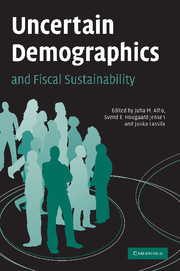Book contents
- Frontmatter
- Contents
- List of figures
- List of tables
- List of contributors
- Preface
- 1 Introduction
- Part I Uncertain demographics
- Part II Measuring sustainability in a stochastic environment
- Part III Enhancing sustainability
- 7 Evaluating pension reforms in the German context
- 8 Longevity adjustment of pension benefits
- 9 Ageing, demographic uncertainty and optimal fiscal policy
- Comment: Computable equilibrium models in policy analysis: future directions
- Part IV Extensions
- Index
- References
8 - Longevity adjustment of pension benefits
Published online by Cambridge University Press: 22 September 2009
- Frontmatter
- Contents
- List of figures
- List of tables
- List of contributors
- Preface
- 1 Introduction
- Part I Uncertain demographics
- Part II Measuring sustainability in a stochastic environment
- Part III Enhancing sustainability
- 7 Evaluating pension reforms in the German context
- 8 Longevity adjustment of pension benefits
- 9 Ageing, demographic uncertainty and optimal fiscal policy
- Comment: Computable equilibrium models in policy analysis: future directions
- Part IV Extensions
- Index
- References
Summary
Introduction
An increase in the life expectancy of elderly individuals can put a strain on the finances of a defined-benefit pension system if it means there are more retired people receiving benefits. In a pay-as-you-go (PAYG) system this increases the contribution levels. In anticipation of future increases in life expectancy, several countries have passed laws that automatically adjust pensions if life expectancy changes. The aim is to preserve the expected present value of future pensions. If benefits are received for more years, pensions per year will be lower.
The popularity of this type of adjustment among policy planners is easy to understand – it is likely to cut pension expenditure significantly if current trends in mortalities continue. In the eyes of the public it can also be defended with an intergenerational fairness argument, because changes in life expectancies would have smaller effects on the present values of future pensions of different cohorts.
In countries that have applied longevity adjustment or are considering doing so, its expected effects have been investigated in some detail. However, the fact that future mortality developments are uncertain has not received much attention. For pension contribution rates this is not a serious deficiency; the adjustment itself takes care of most of this uncertainty. But this uncertainty does exist for monthly pension benefits and replacement rates. Although the size of the adjustment will usually evolve slowly over time, it is worthwhile trying to form a picture of the effects well in advance.
- Type
- Chapter
- Information
- Uncertain Demographics and Fiscal Sustainability , pp. 137 - 160Publisher: Cambridge University PressPrint publication year: 2008
References
- 2
- Cited by



